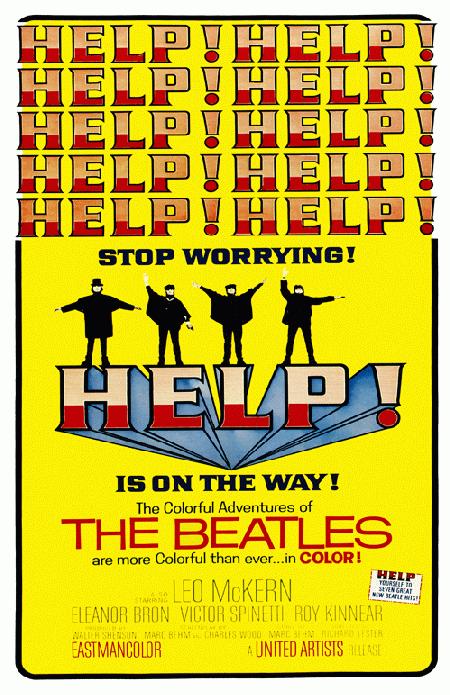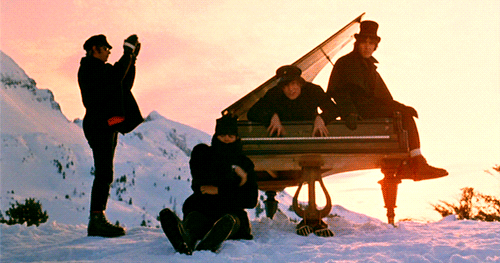Help!
Directed by Richard Lester–1965–92 minutes
The Beatles’ first film, “A Hard Day’s Night”, gets the lion’s share of love when it comes to the Fab Four on the big screen. And why not? It arrived during the highwater mark of Beatlemania and gave it back to fans as the fully-formed global sensation it was: fresh, frantic, witty and full of promise for the grand new youth culture to come. Its B&W pseudo-documentary style, under the self-confident direction of American expat director Richard Lester, gave it a look that impressed more neutral viewers and critics alike (“The Citizen Kane of jukebox musicals,” Andrew Sarris famously proclaimed in the Village Voice.) Insatiable demand promised that another Beatle movie would soon follow.
Almost exactly a year later, along came “Help!” The two most noticeable differences, of course, was the vivid color photography and the conceit of having the boys being on the business end of comic villainy in a light satire of the Bondian action-spy flicks then coming into vogue. The latter element is often held up as to why this entry will never match up to “Hard Day’s Night” and that’s fair enough. Lester, who “got” the Beatles and had a good working relationship with the four, was on board for the follow-up and was not keen to repeat himself. Also, after a couple of world tours where they found themselves sequestered in hotel rooms as protection against ever-increasing hordes of Beatlemaniac girls, the band were not eager to reprise scenes of being chased through train stations by roving packs of delirious teenagers. (In fact, for greater realism, Lester let some of these scenes happen on location instead of staging them, leaving the band unamused). In fact, the only “fans” we really see come right at the band’s first appearance (not counting the filmed title song) where the boys are seen entering a rowhouse by four adjacent doors and a pair of admiring middle-aged housewives wave at them, agreeing that “Adoration hasn’t gone to their heads one jot.”
When the Beatles enter the house (which is a large one-room communal apartment) a viewer first gets a sense of a new mod era taking hold. The monochrome “Hard Day’s Night” still has the look of gritty post-war England but this way-out bachelor pad is something altogether different. John has a recessed bed area, George has an indoor mini-lawn and employs a gardener who uses a set of false teeth for mowing, Ringo has a row of vending machines and Paul has a console organ that rises up from the basement—with comic books on the stand instead of sheet music. It’s in and around this place that the band’s adversaries, a bizarre religious sect with claims to a gaudy red gemstone ring worn by Ringo, first show up. This pan-Asiatic cult needs this particular piece of jewelry as part of their regular ritual of sacrificing humans. They are joined in the bad guy department by an inept mad scientist who knows of the ring’s mysterious powers and wants to use it to “dare I say it, rule the world.” The plotline that follows is sketchy and fairly ridiculous, mainly consisting of implausible and elaborate attempts to capture the Beatles humble drummer. All of these attempts fail with remarkable precision. But the threat does get the band out of the house and into scenic locations like Salisbury Plain, the Alps and the Bahamas—the latter two places also doubled as brief R&R trips for the overworked quartet.
Dick Lester and actress Eleanor Bron look back in this recent making-of clip.
Though the film still gets its share of nitpicking and lukewarm reviews, after a half century you have to wonder why. Much of “Help!” is pretty hilarious on its own terms. Sure, the over-busy action mechanics make it sometime feel (as Lennon suggested) that the Beatles were supporting players in their own film. But it’s a great group to be occasionally overshadowed by. The great Aussie actor Leo McKern plays cult leader Clang and the exotic but personable Eleanor Bron is also good as the cult’s turncoat femme fatale. Victor Spinetti, the put-upon TV producer in “Hard Day’s Night” returns as the mad scientist and is well-teamed with Lester regular Roy Kinnear as the bumbling assistant.
The seven new songs here show that the still-zany onscreen Beatles were showing more emotional depth in their writing as they eased into their rewarding middle period, a satisfying sweet spot between teenybopper rock and psychedelia. In the urgent title song, the formerly self-assured narrator sees that his “independence seems to vanish in the haze.” The romantic resignation of John’s folky “You Got to Hide Your Love Away” and the stately but somber pop of George’s “I Need You” betray this more mature songwriting trend. More upbeat is the Alpine setting for “Ticket to Ride” which utilized real footage of the group taking a ski lesson, while also placing a grand piano on a mountain ridge at sunset, one of many examples of Lester’s wry directorial style. These visual set pieces, often using reflected light and colored filters, have long been celebrated for paving the way for the modern music video. In a special-features interview for a recent DVD release, Lester says he was once sent a letter from the Music Television network (on a parchment scroll, no less) declaring that he was the father of MTV. The ever-clever Lester says he “immediately cabled back and demanded a blood test.”
Cinematographer David Watkins and others discussing the film’s look.
In the end, it’s the native wit of Lester and the Beatles (along with the music, of course) that is lasting takeaway from “Help!” The blend of the silly and subversive had already been honed by Lester in his previous work with Peter Sellers and Spike Milligan, which brought him to the attention of the band in the first place. The playful wordsmithing of screenwriter Charles Wood was also influential and a repeat viewing reveals certain naughty nuances we may not have noticed as kids. (When the baddies try to saw under Ringo’s drum kit during a recording session, the engineer asks, “Boys, are you buzzing?” John’s reply: “No thanks, I’ve got the car”). The “So this is the famous Beatles/So this is the famous Scotland Yard” routine with Patrick Cargill as the Inspector also shows the insurgent younger generation was not going to take authority at face value any longer. This may be saying a lot for a movie that ends with a chaotic melee on a beach that is barely worthy of the Keystone Cops, but what happened in later years bear it out. Lester would go on to make Sixties signpost films like “Petulia” and “How I Won the War” (the latter starring Lennon). And “Help’s” crowish humor, stream-of-consciousness and extravagant visual gags seem to lead the way to the success of the Monty Python TV series, which debuted four years later. George Harrison, who would later help finance the Python film “Life of Brian” thought of Python as a continuation of the Fab Four and the influence of both appear to be inexhaustible. And up against later Bond-parodies like the Austin Powers series, “Help!” will remain irresistibly shagedelic for many years to come.

